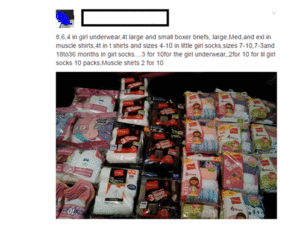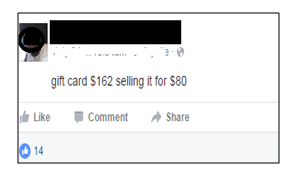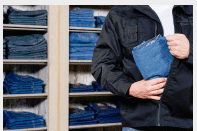Sometimes we simply do not see the obvious even when it is right in front of us. For many years we have worked really hard to hide or disguise Checkpoint Labels. The thought being that the shoplifter will not be able to locate and possibly defeat the label.
But new studies show that although that is still a great strategy, you should also look at the opposite. Putting a clearly identified label in plain sight with a warning on it.
Here is  a good example using one of the newer clear, Checkpoint Systems stock labels. The trademarked “lock” and wording has been tested extensively.
a good example using one of the newer clear, Checkpoint Systems stock labels. The trademarked “lock” and wording has been tested extensively.
Rather than bore you with all the details of the study, I will simply tell you that it works and works well. Visible tagging can increase sales and reduce loss. The last study found:
As many of you know I, Bill Bregar have been in the loss prevention field most of my career. So now putting that hat on let’s look at this from another view. We know that shoplifters are broken into three distinct groups; Impulse, Amateur and Professional.
The bulk of shoplifters you encounter are Impulse. I teach this in my shoplifting classes, which by the way I conduct live, in person or by webinar and are FREE of charge to Loss Prevention Systems customers. I always explain that Impulse shoplifters are easily deterred with employee contact. In other words if you greet the Impulse shoplifter with eye contact, a simple hello and “can I help you”, many studies show that the Impulse shoplifter will most likely NOT shoplift during that visit.
Well if we now apply the thought of a Checkpoint Systems visual deterrence label it makes sense. Given the same circumstances where the Impulse shoplifter has not been greeted but is faced with a visual deterrence label it casts enough doubt into their minds that they do not steal.
Well if that is the case then why doesn’t a sign like this work?
Besides being funny to us I have learned that signs do very little. Probably because of sign “pollution”. They either don’t see it or it is really not a threat. But a specific label on the merchandise they are considering stealing, casts doubt. They do not know what other element may be protecting that merchandise.
Something to consider! If you would like some samples of these labels just reach out to us. We will get them in the mail to you at no charge.


 ” is well aware of how she is obtaining the merchandise and are even encouraging the actions. These are the types of people that hurt big box retailers and that can put small shops out of business. These are the shoplifters we need to focus on and the ones that the criminal justice system need to come down hard on. The only thing that will stop Jane from stealing is being behind bars. This is her full time job.
” is well aware of how she is obtaining the merchandise and are even encouraging the actions. These are the types of people that hurt big box retailers and that can put small shops out of business. These are the shoplifters we need to focus on and the ones that the criminal justice system need to come down hard on. The only thing that will stop Jane from stealing is being behind bars. This is her full time job. 

 The amount of calls reported by Walmart stores to the local police are staggering.
The amount of calls reported by Walmart stores to the local police are staggering. You know, we talk about the thousands of ways you, the small business owner, loses money to thieves constantly. Most of that is centered on shoplifters and boosters stealing your merchandise. We talk about that for good reason… it’s one of the biggest financial impacts to your business if left unchecked. However, there are so many other ways that your business can be targeted by criminals and some of them may appear so legitimate, that you would have no idea you were a victim for weeks. In that time, the criminal is long gone and you’re left paying for that theft out of your pocket. One area of training that is often overlooked in retail is check fraud. I’ll give you some advice on how to identify this in your store and protect yourself from vulnerability.
You know, we talk about the thousands of ways you, the small business owner, loses money to thieves constantly. Most of that is centered on shoplifters and boosters stealing your merchandise. We talk about that for good reason… it’s one of the biggest financial impacts to your business if left unchecked. However, there are so many other ways that your business can be targeted by criminals and some of them may appear so legitimate, that you would have no idea you were a victim for weeks. In that time, the criminal is long gone and you’re left paying for that theft out of your pocket. One area of training that is often overlooked in retail is check fraud. I’ll give you some advice on how to identify this in your store and protect yourself from vulnerability. What is the solution to shoplifting and employee theft?
What is the solution to shoplifting and employee theft? Employee theft is a common and costly problem in retail. Some businesses’ are reporting that, for the first time, internal pilferage has now surpassed external. There are many ways to control and manage internal theft. But, one of the most effective ways is often overlooked. Stop it before it starts.
Employee theft is a common and costly problem in retail. Some businesses’ are reporting that, for the first time, internal pilferage has now surpassed external. There are many ways to control and manage internal theft. But, one of the most effective ways is often overlooked. Stop it before it starts.